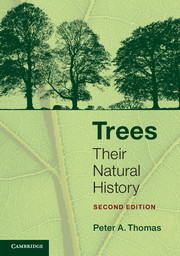Book contents
- Frontmatter
- Epigraph
- Contents
- Preface
- Chapter 1 An overview
- Chapter 2 Leaves: the food producers
- Chapter 3 The trunk and branches: more than a connecting drainpipe
- Chapter 4 Roots: the hidden tree
- Chapter 5 Towards the next generation: flowers, fruits and seeds
- Chapter 6 The growing tree
- Chapter 7 The shape of trees
- Chapter 8 The next generation: new trees from old
- Chapter 9 Age, health, damage and death: living in a hostile world
- Chapter 10 Trees and us
- Further Reading
- Index
Preface
Published online by Cambridge University Press: 05 July 2014
- Frontmatter
- Epigraph
- Contents
- Preface
- Chapter 1 An overview
- Chapter 2 Leaves: the food producers
- Chapter 3 The trunk and branches: more than a connecting drainpipe
- Chapter 4 Roots: the hidden tree
- Chapter 5 Towards the next generation: flowers, fruits and seeds
- Chapter 6 The growing tree
- Chapter 7 The shape of trees
- Chapter 8 The next generation: new trees from old
- Chapter 9 Age, health, damage and death: living in a hostile world
- Chapter 10 Trees and us
- Further Reading
- Index
Summary
Preface
A lot has happened in the tree world since this book was first written. Some previously unanswered questions can now be addressed, and some things we thought we knew have proved to be wrong or not the whole story. These have been put right. Our understanding of trees has also made huge leaps in areas such as the role of genetics and genetic engineering, effects of climate change, hydraulic engineering (including the bitter debate over how water gets up a tree), factors limiting tree height and why trees have colourful leaves in the autumn. New material has been added on all these and in many other areas where new discoveries have been made. This ranges from the surreal (did you know that cosmic radiation and the ocean tides appear to affect tree growth?) to the practical (why have artificial wine bottle corks proliferated?). Many of the problems faced by trees are caused by us humans, so there is also a new chapter on our interactions with trees looking at just why they are good for us and therefore worth preserving. I hope you have as much fun reading this as I had writing it.
Following comments on the first edition, the number of references at the end of each chapter has been increased to help those who want to dig deeper. To keep the text flowing, however, I’ve only included reference to these in the text where it is not clear which source is being used. Also following reader feedback, more scientific names of trees have been included with the common names, which I hope you won’t find too intrusive.
- Type
- Chapter
- Information
- TreesTheir Natural History, pp. ix - xPublisher: Cambridge University PressPrint publication year: 2014

